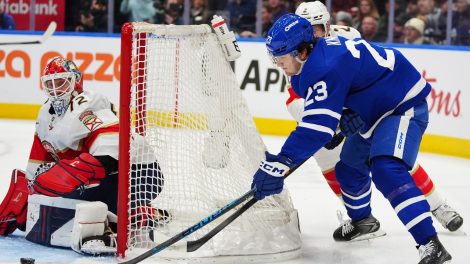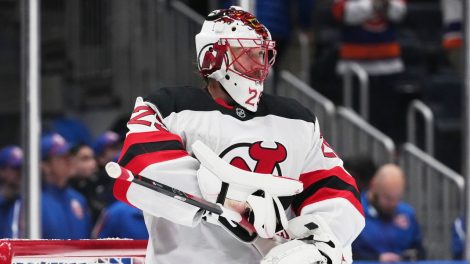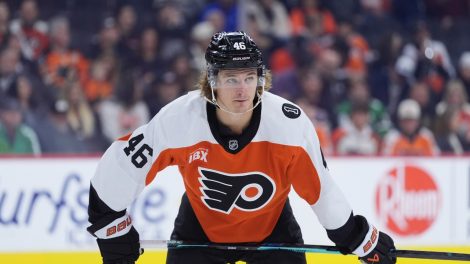Everyone already knows everything there is to know about megastars Connor McDavid, Sidney Crosby, Alex Ovechkin and Erik Karlsson. They’re difference makers who will play a deciding role in the fates of their team and the league.
Instead of latching on to low-hanging fruit, let’s instead shine the spotlight on a handful of other names that figure to play an important role for their teams this year. These are players who have something to prove, are poised to make the next step, or hold the keys to their team’s fortunes.
Because of that, we should be closely following the progress of these players as the year goes on.
Steven Stamkos
It feels like cheating having Stamkos on this list given that he surely would’ve been included among those top-tier stars above just a couple of years ago. At the same time, it also feels like we’ve collectively been sleeping on the fact that a) the Lightning had to play out the final 65 games of last season without Stamkos and b) he’s now fully healthy and ready to go from the jump this year.
It’s understandable that people are skeptical of Stamkos this season, given how much time he’s missed. At this point it’d be irresponsible to project him to play in all 82 games, or expect him to get back to lead the league in scoring again.
What should provide optimism here, however, were the inklings we saw that he was finally starting to round back into the form he held as one of the league’s preeminent scorers prior to his catastrophic leg injury back in 2013. Playing with Nikita Kucherov and Vlad Namestnikov (a line that figures to be reunited to start the year) did wonders for helping rejuvenate Stamkos at five-on-five and brought out the best version of him we’d seen in years. It reversed the course of his downward slide:
| Season | Goals/Hour | Points/Hour | CF% | Relative CF% | Expected GF% | Relative Expected GF% |
|---|---|---|---|---|---|---|
| 2010-2011 | 1.33 | 2.55 | 52.08 | -0.35 | 53.74 | 2.42 |
| 2011-2012 | 1.81 | 2.79 | 48.36 | 2.24 | 48.67 | 2.05 |
| 2012-2013 | 1.07 | 2.29 | 49.48 | 3.37 | 50.44 | 2.95 |
| 2013-2014 | 1.56 | 2.56 | 53.79 | 3.55 | 53.69 | 5.75 |
| 2014-2015 | 1.28 | 2.15 | 52.90 | -0.39 | 53.19 | -1.62 |
| 2015-2016 | 0.93 | 1.69 | 51.02 | -1.77 | 48.11 | -5.06 |
| 2016-2017 | 1.37 | 3.29 | 56.16 | 8.79 | 52.11 | 5.54 |
(All data via Corsica and Natural Stat Trick)
Whichever version of Stamkos we get will impact Tampa’s place in the standings. Will we get the fully-loaded peak version of Stamkos, or will he slink back to being the declining goal scorer he was post-broken leg?
If he’s the former, it will provide a compelling wrinkle to the argument that the Lightning will bounce all the way back to being the top challenger to the Pittsburgh Penguins and their hold on the Eastern Conference and Stanley Cup.
Leon Draisaitl
Given how successful Draisaitl and Connor McDavid were at terrorizing the opposition whenever they shared the ice last season, it’s understandable that the decision of whether or not to keep them together is a difficult one for coach Todd McLellan.
They essentially made their intentions clear the moment they inked Draisaitl to an eight-year, $68-million deal this summer. That contract made Draisaitl the 10th-highest paid player in the league this season, a payday that also signalled the Oilers envision his long-term landing spot as the 1B to McDavid’s 1A down the middle.
Of the two possibilities, splitting them up seems to make the most sense. That unrelenting 1-2 punch a la Sidney Crosby and Evgeni Malkin would put the rest of the league in a grinder by presenting them with an impossible problem to solve. By opting to spread the wealth rather than loading up on top, they’d ensure the opposition wouldn’t be able to focus the brunt of their defensive forces on stopping one line. Having McDavid and Draisaitl on separate lines makes the Oilers a significantly more difficult team to deal with.
At this point we can say with unabashed confidence that McDavid has vaulted into the rare pantheon of superstardom where everything he touches turns to gold, and everyone he plays with will have their value inflated.
Draisaitl’s case is a bit more iffy, because aside from a number of playoff games last spring, we didn’t really get a chance to see how capable he was of carrying his own line yet:
| Combination | Ice Time | CF% | FF% | SF% | GF% |
|---|---|---|---|---|---|
| Draisaitl with McDavid | 674.03 | 53.85 | 55.07 | 55.62 | 59.42 |
| Draisaitl without McDavid | 500.03 | 47.74 | 47.45 | 45.03 | 44.19 |
| McDavid without Draisaitl | 636.52 | 52.23 | 53.16 | 52.28 | 65.45 |
(CF%= % of Shot Attempts controlled by Oilers, FF% = % of Unblocked Shot Attempts controlled by Oilers, SF% = % of Shots on Goal controlled by Oilers, GF% = % of Goals scored by Oilers)
This doesn’t mean Draisaitl can’t be that type of player. He’s only 21 years old, which means there’s plenty of room for development ahead. He also already passes the eye test with flying colours, boasting all of the tools you’d like to see from a top young player. Most importantly, he’s shed any residual concerns there may have been about his skating ability back when he was a draft prospect.
It’s just slightly unnerving that the Oilers made the type of financial commitment to him they did, without fully vetting whether he was truly capable of being what they paid for.
If he can carry his own line while maintaining his offensive output, then it’s a no-brainer deal you make if you’re the Edmonton Oilers. If he can’t, though, and settles into a role as McDavid’s running mate on the wing, you’ve still at least got yourself a luxury.
But it’d be a luxury instead of a necessity, and one that you’re paying an awfully steep premium for in lieu of addressing more pressing needs elsewhere. And that undoubtedly presents a whole new set of financial questions that’ll eventually need to be answered.
Nathan MacKinnon
On the one hand, it’s easy to lose sight of the fact that MacKinnon just turned 22 years old. On the other, it’s hard not to look at what he’s done thus far in his career as something of a disappointment given the sky high expectations he came into the league with as a first overall pick.
That’s likely due to the fact that his offensive production has been trending in the wrong direction since his tremendous rookie season:
| Season | 5v5 Goals/Hour | 5v5 Points/Hour |
|---|---|---|
| 2013-2014 | 0.72 | 2.07 |
| 2014-2015 | 0.70 | 2.02 |
| 2015-2016 | 0.58 | 1.63 |
| 2016-2017 | 0.52 | 1.62 |
The caveat that’s important to note about MacKinnon is that despite the fact the box car counting stats haven’t been there, he’s still managed to be effective in more subtle ways. At 5-on-5, he’s drawn 45 more penalties than he’s taken in his first four seasons thanks to the blazing speed he possesses. He’s also generated a high volume of shots, which in theory is considered to be a good thing, but may be more of a negative here given his inexplicably poor finishing ability:
| Season | MacKinnon’s Shooting % | League Average Forward Shooting % |
|---|---|---|
| 2013-2014 | 10.00 | 10.43 |
| 2014-2015 | 7.29 | 10.39 |
| 2015-2016 | 8.57 | 10.58 |
| 2016-2017 | 6.56 | 10.74 |
To put all of those individual struggles to turn shots into goals into perspective, here’s a look at how many more times he would’ve scored in each season if he was a league average finisher:
| Season | Actual Goals Scored | League Average Expectation |
|---|---|---|
| 2013-2014 | 24 | 25 |
| 2014-2015 | 14 | 20 |
| 2015-2016 | 21 | 26 |
| 2016-2017 | 16 | 27 |
I’m not entirely sure what to make of all of this. One theory is that MacKinnon still doesn’t know how to harness his immense speed and winds up putting himself in suboptimal shooting positions. But that’s more anecdotal than anything else.
This is why MacKinnon is on this list – even though the Avalanche aren’t going anywhere this season, he is one of the more fascinating players to keep an eye on because of how large the discrepancy is between how good our eyes tell us he should be, and how good he’s actually been so far. If you watch him on the right occasion – especially on an international stage where he’s playing with gifted players – you come away thinking there’s no reason why he shouldn’t be one of the most dominant NHL players.
As I generally do in these unique cases I’ll bet on the talent and youth eventually winning out over time, but these struggles have persisted long enough that there might be something more to it than meets the eye.
Ryan McDonagh
In terms of a change in surroundings from one season to the next, there may be no bigger winner out of the summer than Ryan McDonagh. After years of being strapped to Dan Girardi, he has now finally been freed to run wild and explore the world with Kevin Shattenkirk as his new partner. The splits for McDonagh with and without Girardi over the years aren’t necessarily surprising, but are remarkably telling:
| Season | TOI with Girardi | Shot % with Girardi | Chance % with Girardi | Goal % with Girardi |
|---|---|---|---|---|
| 2013-2014 | 1113.07 | 50.15 | 50.48 | 54.23 |
| 2014-2015 | 925.34 | 48.51 | 48.85 | 51.57 |
| 2015-2016 | 472.07 | 43.33 | 42.95 | 64.11 |
| 2016-2017 | 779.15 | 43.75 | 44.65 | 46.12 |
| Season | TOI without Girardi | Shot % without Girardi | Chance % without Girardi | Goal % without Girardi |
|---|---|---|---|---|
| 2013-2014 | 241.52 | 55.42 | 57.91 | 43.72 |
| 2014-2015 | 271.48 | 54.51 | 49.82 | 65.97 |
| 2015-2016 | 472.07 | 53.12 | 55.14 | 62.65 |
| 2016-2017 | 236.39 | 54.76 | 55.10 | 64.08 |
It doesn’t exactly require a lot of mental gymnastics to reach the conclusion that McDonagh’s on-ice numbers will skyrocket now that he’s free from Girardi and playing with a net positive five-on-five partner. For us viewers, however, an even more interesting byproduct of the change will be seeing if and how McDonagh’s game opens up and evolves stylistically.
Watching McDonagh navigate this new, joyous world could present us with one of the more aesthetically pleasing stories of the 2017-18 season, and the Rangers with a much needed shot in the arm.
Scott Darling
The Carolina Hurricanes are one of the most trendy consensus sleeper picks this season, and with good reason. Unlike the past couple of years where they’ve had similar hype only to wind up falling short of expectations, there’s legitimate reason to believe this season is different.
That optimism begins and ends between the pipes, a position they finally focused on improving this off-season when they acquired Scott Darling from the Chicago Blackhawks. Despite the fact the Hurricanes have regularly been one of the better puck possession teams in the league under Bill Peters, none of it has ultimately mattered because their goaltending units haven’t been able to stop the puck with any consistency:
| Season | 5v5 Save % | League Rank | All Situations Save % | League Rank |
|---|---|---|---|---|
| 2014-2015 | 90.89 | 29th | 90.21 | 27th |
| 2015-2016 | 91.45 | 28th | 90.23 | 29th |
| 2016-2017 | 91.26 | 29th | 90.09 | 27th |
The reason Darling is particularly intriguing here is because he’s still a relatively unknown commodity. Carolina’s investment in him is reminiscent of the bet the Edmonton Oilers made on Cam Talbot a few summers ago, when he had an impressive albeit limited track record to analyze.
While there’s no denying he’s sparkled during his brief NHL career thus far, it only spans 75 total games sprinkled throughout three separate seasons. Dating back to his junior and collegiate career, the most games he ever appeared in during a single season was 42 a decade ago in the USHL.
Much like Talbot, if Darling is able to hold up under a workload he’s never really had to shoulder before, he’ll do wonders for Carolina over the top and turning them from a tantalizingly talented group into a legitimately competitive one that finally makes its triumphant return to the post-season.
[relatedlinks]







